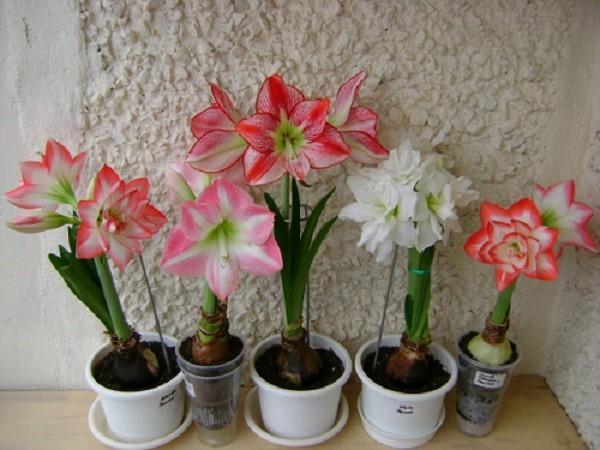We grow amaryllis at home
 Amaryllis is one of those indoor plants that even the most inexperienced growers can grow. Sometimes it is also called "a flower for the lazy", because it is completely unpretentious in care. If from the very beginning some features are taken into account, in the future the plant will not cause much trouble, and a gorgeous peduncle will soon appear from the bulb.
Amaryllis is one of those indoor plants that even the most inexperienced growers can grow. Sometimes it is also called "a flower for the lazy", because it is completely unpretentious in care. If from the very beginning some features are taken into account, in the future the plant will not cause much trouble, and a gorgeous peduncle will soon appear from the bulb.
So, to grow amaryllis at home, you must:
- choose a suitable pot;
- prepare nutrient soil;
- provide him with diffused lighting;
- water and feed the flower in a timely manner;
- organize a dormant period after flowering;
- replant regularly.
If it is necessary for the amaryllis to bloom by a certain date, it must be planted 4-6 months before its onset.
Soil and flowerpot for amaryllis
Pot for amaryllis it is better to take it not very deep, but not quite flat, so that the roots have room to grow. At the same time, in order for the plant to bloom faster, you should not use a too spacious container - an additional 3 cm in diameter is quite enough (compared to the bulb).
The larger the bulb, the larger the amaryllis inflorescences will be.
The earth must be nutritious and light so that the water passes well through the layers and does not stagnate. You can use a universal commercial substrate for this purpose. It contains the elements necessary for the plant, and is also loose, which means that the soil will dry out well.
Watering and feeding
Amaryllis should be watered abundantly only after it has released a flower arrow up to 10 cm high, otherwise the bulb will grow leaves instead. Until then, just keeping the soil slightly moist is sufficient. During flowering, the plant needs more moisture, but here it is important to find a middle ground, because each room has its own microclimate: someone has a warmer and the earth dries out faster, others have a cooler temperature, so the soil retains moisture longer.
Excessive watering is detrimental to amaryllis: it causes rotting of the bulb and further death of the flower. And from a lack of moisture, its leaves become lethargic, and the bulb itself begins to wrinkle and dry out.
As for dressing, some growers read to make complex mineral fertilizers as early as 2 weeks after planting the bulb. Others wait for the plant to bloom. However, if the flower was planted in nutrient soil and there are no developmental problems, it is better to use the second option. Top dressing should be carried out no more than 2 times a month.
Rest period and transplant
When the amaryllis fades and its inflorescences fade, it is necessary to cut off the top of the peduncle. It is not necessary to remove the entire aerial part of the plant at once - along the “decapitated” peduncle, nutrients will gradually pass into the bulb. Provided that the frequency of watering decreases over time, both the leaves and the peduncle will fade on their own. Then they need to be cut off, and the bulb should be placed in a cool room for 2-3 months. During this time, she will gain strength before a new flowering.
About once every three years, amaryllis are transplanted, changing the ground to fresh, as well as separating the formed children so that they do not take away the strength necessary for flowering from the mother bulb.